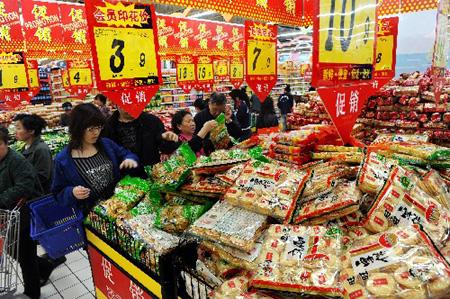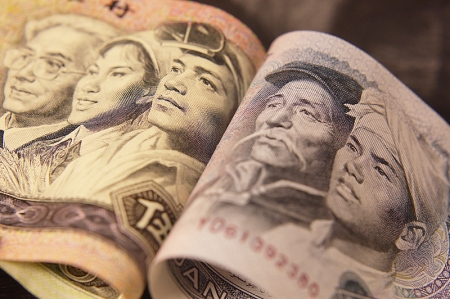May 21th, it is reported that many SMEs in clothing and footwear industries in Guangdong are mired in difficulties. This has aroused great concerns in the industry and made many wondering why this case is. After intensive interviews reporters learned that it is the sudden ups and downs in the price of raw materials, rising labor costs and exchange rate appreciation that have made these factories unable to bring about competitive quoted price, which have driven the foreign orders to Southeast Asia and send these factories into a frantic competition for domestic orders. And as a result, the heated competition has sent small and medium sized clothing and footware factories in Guangzhou into semi-suspension.
With the Foreign Orders Shifted Elsewhere, Companies Aimed at Domestic Market
Xintang is a world-famous jeans production base. According to Zhan Xueju, Xingtang’s president, there are altogether 2000-3000 jeans factories of all sizes. And more than 65% of products are sold abroad. For various reasons, overseas orders are now much less than before.
According to Zhan Jiahe, vice president of the Municipal Federation of Industry and Commerce, in the past his company mainly dealt with foreign orders, at peak time the monthly jeans production was as high as 300-400 thousand sets. But now the foreign order per month has shrunk to 30-40 thousand sets.
Zhan Jiahe said that in the past orders from the United States are the largest. But recently they seldom can get such orders. The profit margin from the U.S. orders is already very narrow, plus the rise of the labor cost and the appreciation of RMB against the U.S. dollar, making these factories’ quoted price too high for the customers to accept. As a result, those customers shift their order to India and Philippine.
Mr. Liang is the owner of a medium and large sized company specialized in making high-end shoes for export. All of his products are sold to European and American markets. According to him, from March to May this year, the orders are about one-third less than in previous years, which is mainly because that after cost accounting, the quoted price was too high for the overseas customers to accept.
According to Guo Zhenhua, owner of the Bao Fu Rubber Products Factory in Sanxiang, Zhongshan city, many foreign businessmen have shifted their Low-end shoe orders to Vietnam, Bangladesh and Indonesia. They only put the order in China when it comes to technically demanding high-end footwares.
Zhan Jiahe said that as foreign orders keeps on shrinking, factories began to shift their focus to domestic orders, making the competition on the domestic market became increasingly intense. Located on Dadun road, Xintang Qige garment factory has been focusing on the domestic market. According to one of its partners Yan Dunquan, in the past the factory had an annual turnout of over a 100 million pieces of jeans, but now the monthly order is only 30,000 pieces or so.
Pressure I Rising Labor Cost
When it comes to the reasons leading to the present predicament, there are two major complaints from the owners of the SMEs. The first one is the rising labor cost and recruiting difficulties. And the second on is the soaring raw material price. After interviewed a number of small business owners in Xintang, your correspondent learned that, despite the rising wages, the recruitment difficulty is still a common problem.
Zhan Jiahe said that last year, the wages in the factory rose by 15% and again up by 17% this year. Over the last two years, labor costs alone rose by 30% or more. But it can not alleviate the recruitment difficulties, many workers still do not want to stay in the factory. They would rather be temporary workers who worked for a short period of time and left the factory when the salary is due. They are locally known as “grassroots.”
According to Li Yongqiang, a manager in a garment factory, in 2008, the processing cost for jeans was approximately 1.8-1.9 yuan per piece. But now the cost was 3-3.2 yuan per piece, up by 70%. But still the factory is unable to retain workers. It is estimated that of all the workers he knows, about a quarter of them are “grassroots”.
Zhou Jianping, a clothing factory manager, said that nine out of ten factories are experiencing a low business season. They seldom can get orders, but even if they do get the orders, they cannot guarantee the quality and time of delivery because the workers are getting loose.
Pressure ? The soaring raw material price has deterred the factories from accepting the orders
The rising raw material price is one of the important reasons why the vast number of SMEs in trouble. Zhan Jiahe said that in previous years when cotton prices are very stable, the cost of garment factory are very easy to control, and market expectations and sales are stable, too , but in the second half of last year, as cotton prices experienced huge ups and downs, garment manufacturing enterprises suffered from more and more pressure. For example, in the year before the last, cotton yarn of good quality is only 18,000yuan / ton, in the last year it rose to as high as 43,000 yuan / ton, and now it is still holding up at 37,000 yuan/ ton.
Zhan Jiahe said that with the rising cotton price comes fewer orders, making goods flow slowly. However, today as the cotton price falls, the business situation is still hard. And as people tend to hold a speculative attitude toward the market, the flown of goods is still very slow. During Financial crisis when exchange rates and cotton prices are stable, the cost can be expected and the price can be put under control, but now, due to the rising labor cost, cotton price falls dramatically, making the risk increasingly large and deterring the factories from accepting orders.
Kwok Chun-wah said that in the past year, rubber cost rose 100 percent, as for fabrics ,about 30%, and labor cost also rose by 10%, making the overall production costs of footwear rise by 30% to 40%.
Chen Wusi also said that though the price of the product increases, it can never match the step of the rising cost, making the profit margins become smaller and smaller. “if the current situation continues, the company’s factory in Zengcheng can only struggle to live for 3 to 5 years before its relocation or restructuring.”
Pressure ? With the appreciation of RMB, profit from export is shrinking
Along with the soaring price of labor and raw materials, the appreciation of RMB against the U.S. dollar has also generated pressure on export-oriented small and medium enterprises. Ever since June 19 last year, RMB decoupled with the dollar again and began to move towards the road of steady appreciation. By far, the RMB has appreciated by more than 5%. Guo Zhenhua said that the profit from low-end footwear export is only 0.2 dollars a pair, even the profit for high-end shoes is only about $ 1 dollar a pair. And from quoting to shipment, it costs these products generally six months or so. In these six months time, if the RMB exchange rate appreciation as much as 3%, then the factory could make no profit out of it.







